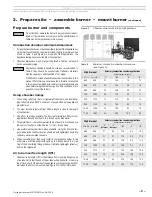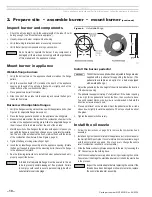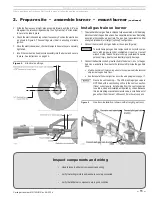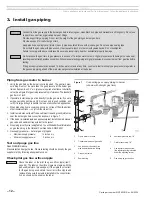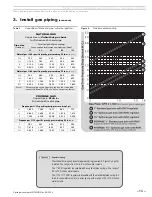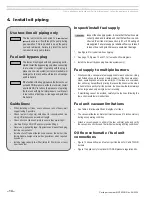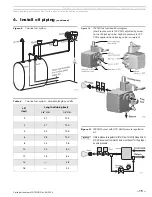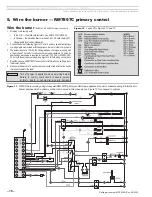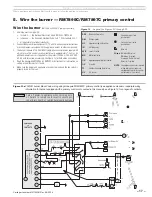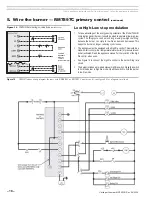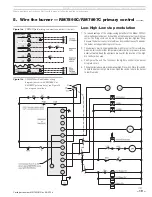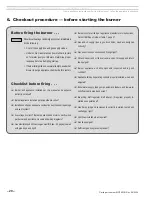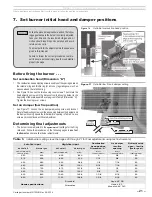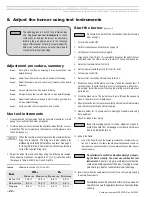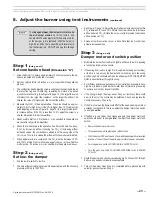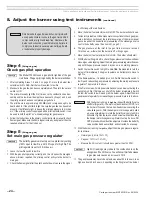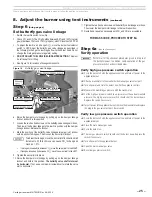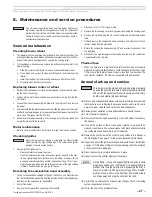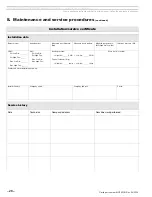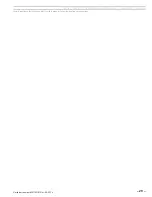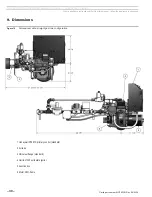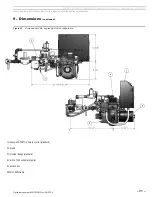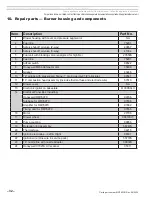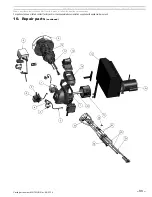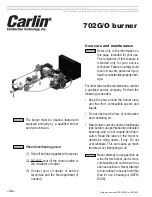
Model 702G/O Advanced gas/oil burners — Instruction manual
Carlin part number MN702GO Rev. 06/23/14
– 23 –
Where appliance instructions differ from this manual, follow the appliance instructions.
8. Adjust the burner using test instruments
(continued)
3.
See Figure 17, page 19. Adjust the low-fire damper screw until the low-fire
CO
2
is between 11% and 12%. Rotate the screw clockwise to increase
airflow (reduced CO
2
). Rotate the screw counterclockwise to decrease
airflow (increase CO
2
).
4.
Smoke at low fire must be zero or a trace. Note that too much air can
actually increase smoke.
Step 3
(firing on oil)
Damper motor end switch position
1.
Modulate the burner from low fire to high fire and back to low fire, pausing
at each step for about one minute.
2.
If the swing from low fire to high fire is rough (burner bangs or rumbles),
or the fire is very smoky, the damper end switch may be in the wrong
position. High-fire oil should pull in as the air damper, NOT THE DAMPER
ARM, is about halfway through its swing.
3.
For different appliance applications, it is sometimes necessary to have
high-fire oil pressure pull in earlier or later than normal during the swing
to achieve a smoother, cleaner transition.
4.
If the swing is rough (flame goes out, bangs or rumbles), there could
be air in the oil, or the nozzle may be defective. Check, and replace the
nozzle if necessary. Then retry.
5.
If the fire is too lean, the flame could lift off of the head, causing rumble or
unsteady combustion. In this case, adjust the damper motor end switch
to energize earlier.
6.
If the flame is very smoky, then cleans up again, the damper motor end
switch should be set to energize later. To adjust the damper motor end
switch:
•
Remove the damper motor cover.
•
This will expose a white plastic gear with notches.
•
With the burner OFF, use the end of a small-bladed screwdriver inserted
into one of the notches of the white gear to rotate the gear as needed.
•
Turn the gear one notch CLOCKWISE for a LATER PULL-IN.
•
Turn the gear one notch COUNTERCLOCKWISE for an EARLIER
PULL-IN.
7.
Restart the burner and check modulation again. Continue with 1 through
6 above as needed until results are acceptable.
8.
Turn off the burner when Step 3 is completed before proceeding with
setup for gas combustion, Step 4.
The linkage between the damper motor arm and
the air damper crank is set at the factory, and
should ONLY need adjustment if the damper motor
or the damper rod is replaced. With the burner in
high-fire position, there should be minimal play in
the connecting rod. DO NOT change this linkage
setting.
Step 1
(firing on oil)
Set combustion head
(Dimension “A”)
1.
Allow the burner to operate approximately 15 minutes to ensure the ap-
pliance is heated and combustion is steady.
2.
Set the overfire draft to -.02 inches w.c., or as specified in the appliance
manual.
3.
The combustion head adjusting screw is used to set the spacing between
the retention ring and throttle ring, regulating how much air passes
around the retention ring. (See Figure 16, page 19.) The larger the value
of dimension A, the larger the clearance, so the larger the airflow. The
smaller the value of dimension A, the smaller the airflow.
4.
Measure the %CO
2
in the appliance flue. The value should be approxi-
mately 12.5% for high fire oil. If the CO
2
is higher than 12.5%, adjust the
head adjusting screw (see Figure 16, page 19) to a larger dimension A
to increase airflow. If the CO
2
is less than 12.5%, adjust the screw to a
smaller dimension A to decrease airflow.
5.
Reset overfire draft to -.02 inches w.c., or as specified in the appliance
manual, after any airflow adjustment.
6.
Check the smoke value in the appliance flue. It must be zero to a trace.
If not, try increasing airflow (reducing the CO
2
)
. If increasing airflow
increases smoke, the combustion is probably on the wrong side of the
CO
2
curve. To correct, increase the airflow until the smoke is eliminated.
7.
When adjustments are completed, the CO
2
must be between 12.0%
and 12.5% at high fire oil, with smoke equal to zero or a trace. Overfire
draft must be -.02 inches w.c., or as specified in the appliance manual.
Step 2
(firing on oil)
Set low-fire damper
1.
Flip the low-fire switch to low fire.
2.
The burner fuel unit blocking valve will be deactivated, and the oil nozzle
pressure will drop to 100 PSIG.

